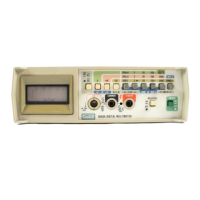THEORY OF OPERATION
SIGNAL CONDITIONING
CM
I
I
I
L
A/D
CONVERTER
COUNTER
INT-ERRUPT
LOGIC
CONTROL
LOGIC
RANGE
AND
FUNCTION SWITCHES
SUBTRACTOR
REFERENCE
I
RELATIVE
I
REFERENCES
::J
DISPLAY
Figure 3-4. Microcomputer
Simplified Block
Diagram
3-20.
Signal Conditioning
3-21.
Some 8050A
inputs must be scaled
and/
or
conditioned before being presented to the
a/
d converter.
For
example, high voltage levels must
be
attenuated, and
ac inputs must
be
attenuated and converted into the
equivalent de voltage levels. The
a/
d converter has two
ranges:
±200 m
V
full-scale and ±2V full-scale. The
following paragraphs describe the signal conditioning
circuits.
3-22. VOLTAGE
SIGNAL CONDITIONING
3-23.
As
Part
A
of
Figure
3-5
shows, the voltage signal
conditioning
is
accomplished with
an
input voltage
divider network. The division factor
of
the network
is
determined
by
the range selected: 1 /
100
for the
20
and
200V
ranges, l/lOOOforthe
lOOOV
dc(750Vac) range.
If
the AC/ DC switch
is
in
the AC position, the output
of
the
divider network will be routed through the true-rms
converter to the
a/
d converter.
If
the
AC/DC
switch
is
in
the DC position, the output
of
the divider network
is
routed directly to the
a/
d converter.
If
the
kfl
switch
is
3-6
--
--~-"
-~--
selected (ohms
or
conductance), the
input
divider
resistors are used as the reference resistors.
3-24.
CURRENT
SIGNAL CONDITIONING
3-25.
As
Part
B
of
Figure
3-5 shows,
current
measurements are made using a selected value current
shunt
to perform the current-to-voltage conversion
required by the
a/
d converter. The range switches
determine
the
value
of
the
current
shunt,
thus
determining the scale
of
the voltage level developed across
the shunt.
If
the AC/ DC switch
is
in the
DC
position, the
output
of
the current shunt is applied to the input
of
the
a/
d converter.
If
the AC/
DC
switch is in the AC position,
the voltage level developed across the shunt
is
applied to
the input
of
the rms converter.
3-26.
RESISTANCE/CONDUCTANCE
SIGNAL
CONDITIONING
3-27.
Resistance and conductance measurements made
on the 2
mS, 2000,
and 2
kfl
ranges use a direct ratio
technique.
Other
ranges use a subtraction and ratio
technique to indirectly derive a ratio.

